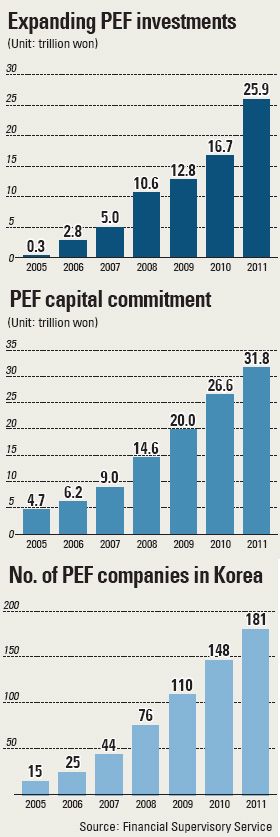PEFs enjoying their time in the sun

Even though the antitrust agency finally ditched the plan, it brought the fund, its exceptional growth rate and a burgeoning new trend into the spotlight.
Particularly it has only been seven years since local private equity funds first appeared in the financial market.
MBK Partners is a majority stakeholder in cable TV operator C&M, financial firms such as Hanmi Capital and KT Rental, which offers everything from servers to medical equipment and cars.
The fund also owns controlling stakes in foreign companies including Universal Studios Japan, Asia’s second-largest theme park.
Rush hour
PEFs such as U.S. buyout firm Lone Star began hitting the local market in 2004 after Korea was forced to open up in the wake of the Asian financial crisis of the late 1990s.
In December of that year, the government and lawmakers drew up regulations allowing for the establishment of local funds with the aim of encouraging M&As.
Interest was limited at first but has mushroomed in the last few years as top-tier investors here became intrigued and jumped on the bandwagon.
According to a recent report by the Financial Supervisory Service (FSS), money pouring into PEFs here ballooned 55 percent last year to reach 25.9 trillion won ($22 billion).
In 2005, the figure stood at a mere fraction of this, or 300 billion won.
The capital commitment, which is the amount of investment that are committed to long-term funds, has grown nearly 20 percent from 2010 to 2011 to nearly 32 trillion won.
Over the same period, the industry has grown from 15 to 181 companies, with MBK Partners ranking as the nation’s largest.
As their ranks, profile and disposable income have swollen, PEFs have also begun splashing out overseas. Last year, Korean funds invested 3.2 trillion won in 20 countries, over double the total investment from 2004 to 2010.
Their investments have also diversified beyond the U.S. and Europe to include emerging markets in South America and oil-rich destinations in the Middle East.
However, they are not only just spreading geographically, but also by sector, with a slow shift taking place away from manufacturing - which investment is still dense - to energy and biotechnology.
Spoilt for choice
Market observers say investors are rushing to snap up PEFs instead of publicly offered funds, a previous fad that exploded in many people’s faces when the global recession hit.
In 2007, a sudden boom in this area took the financial market by surprise as people of all walks of life began stampeding brokerages in hopes of capitalizing on the bullish stock market. However, many subsequently saw their investments plunge due to the Lehman Brothers-triggered credit crunch of late 2008.
As the government responded by loosening its monetary policy and embarking on an era of low-interest deposits, investors have been hunting for safer repositories for their funds.
Although the central bank in the last two years has bumped up the key borrowing rate after it was cut to a historic low of 2 percent, the rate is still considered relatively low at 3.25 percent.
“The exceptional growth of PEFs last year shows that the very rich are ramping up their investments in this area as an alternative to publicly offered funds,” said an analyst at Woori Investment & Securities.
However, while Korea’s PEF market may be accelerating at a much faster rate than the comparable markets in more advanced economies, analysts warn that it is still at an embryonic and, therefore, relatively high-risk stage.
“A lot of companies need to be put on sale for the market to grow, but as so many are still run by their founding families in Korea, this is unlikely to happen soon,” said Lim Hyung-joon at Korea Institute of Finance.
Critics say stringent government regulations are another roadblock as they inhibit funds from pursuing more aggressive growth strategies.
Different strokes
Market experts also urge retail investors to tread carefully and only dip their toes in the pool if they are prepared to take a long swim.
“As PEFs generally represent long-term investments, the wealthy can significantly increase their assets by making huge deposits, but general investors are taking a risk and need to be careful not to overextend themselves before they jump in,” said a Samsung Securities official.
By Lee Ho-jeong [ojlee82@joongang.co.kr]










with the Korea JoongAng Daily
To write comments, please log in to one of the accounts.
Standards Board Policy (0/250자)